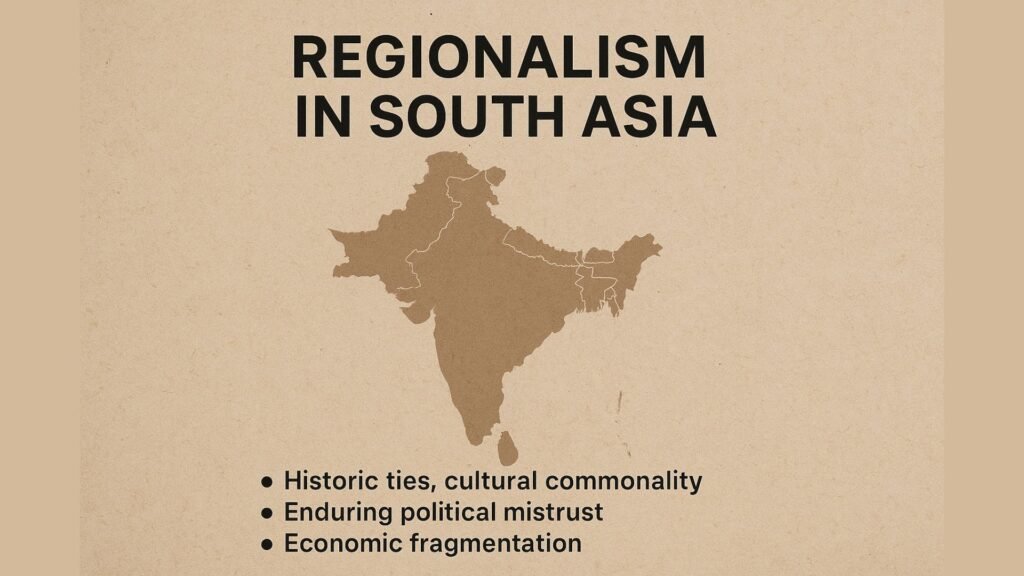Regionalism, as a concept and practice, has emerged as a defining feature of global politics in the post-World War II era. From the formation of the European Union to the rise of ASEAN, the trajectory of regional cooperation across the globe reflects diverse historical, geopolitical, and economic imperatives. However, South Asia remains a perplexing case, rich in cultural commonality and historical ties, yet fraught with enduring political mistrust, weak institutionalism, and fragmented economic integration. This paradox invites a deeper interrogation of regionalism through both comparative and critical lenses.
To assess whether South Asia truly constitutes a “region,” it is imperative to first interrogate what defines a region. Traditional perspectives on regionalism have emphasised geographic proximity as the primary criterion. However, this approach has been challenged by constructivist scholars, most notably Amitav Acharya, who argue that a region is not merely a physical or spatial configuration but a social and ideational construct. As Acharya asserts, “regions are not geographically given, but are socially constructed, made and remade through interactions.”
In an attempt to bridge these physical and ideational frameworks, the IR scholarship on regionalism proposes a more composite understanding: regions should be defined pragmatically by accounting for cultural, linguistic, religious, and developmental similarities alongside geographical contiguity. By these standards, South Asia broadly qualifies as a region. The countries comprising the region share deep historical linkages, linguistic affinities, many languages having roots in the same language family, cultural practices, and common societal norms, particularly strong familial and community institutions.
Yet, defining South Asia as a region in a theoretical sense does not equate to successful regionalism in practice. This distinction is particularly evident in the framework of new regionalism. Unlike classical regionalism, which prioritised economic integration through formal institutions, new regionalism places emphasis on multidimensional and multi-level forms of integration. From this framework, the evolution of “region-ness” occurs across five levels: regional space (mere geography), regional complex (interdependent systems), regional society (regular interactions), regional community (shared identity), and regional institutionalised polity (institutional coherence).
Although South Asia, on paper, appears to satisfy many of these layers, particularly in terms of shared geography, colonial history, and institutional frameworks such as SAPTA and the establishment of the now dormant SAARC, these are largely superficial or rhetorical achievements. The deeper elements of region-ness, such as a shared political vision, robust economic interdependence, and cohesive identity, remain deeply fragmented.
This fragmentation is rooted in several persistent challenges. Despite cultural similarities, the historical experiences of colonialism and partition have embedded enduring contestations over identity and sovereignty. The division of British India in 1947 and the subsequent secession of East Pakistan in 1971 illustrate the persistent inability to forge a unified political identity. Furthermore, despite democratic frameworks in several South Asian states, political systems vary in stability and transparency, and the region continues to be plagued by ethnic and religious nationalism.
Economically, intra-regional trade within South Asia remains one of the lowest globally, constituting a mere 5% of the region’s total trade. This is exacerbated by a lack of economic complementarity and asymmetries in size and development, especially between India and its neighbours. India alone constitutes 73% of the population, 76% of GDP, and 81% of military expenditure within South Asia. It is often noted that regional organisations often falter when power asymmetries dominate inter-state relations, making the pursuit of balanced cooperation inherently difficult.
The most significant roadblock, however, remains the entrenched strategic rivalry between India and Pakistan. Their bilateral conflicts have consistently paralysed collective regional initiatives. Moreover, the growing strategic influence of external actors, particularly China, has further complicated the geopolitics of the region, pulling members in different directions and weakening any cohesive regional posture.
This fragmentation has not only stalled SAARC-led regionalism but has led to the emergence of sub-regional alternatives such as BBIN (Bangladesh, Bhutan, India, Nepal), BIMSTEC (Bay of Bengal Initiative for Multi-Sectoral Technical and Economic Cooperation), and BCIM (Bangladesh-China-India-Myanmar). While these formations have gained some traction, they also reflect the broader failure of South Asia to evolve as a unified regional entity.
Two key insights emerge from this trajectory:
- Strategic and security interests have historically defined regional cooperation in South Asia, rather than deeper cultural or economic integration. This has prevented the formation of a cohesive regional identity and undermined efforts at institutional consolidation.
- The project of region-building has inadvertently produced multiple and competing narratives about South Asia as a region. Instead of reinforcing a shared regional consciousness, the region’s political divisions have given rise to overlapping and contradictory visions of what South Asia ought to be.
Thus, the question of whether South Asia constitutes a “region” is not easily answered. Much depends on how one defines the term. If the criteria are limited to geography, history, and cultural affinities, then South Asia qualifies to a certain extent. However, when the definition is broadened to include sustained economic cooperation, shared political values, and strategic cohesion, the region falters.
The vision of South Asia as a coherent region remains aspirational. From a shared past, the region has unfortunately arrived at a fractured present. The promise of South Asian regionalism continues to be undermined by historical legacies, inter-state rivalries, and a failure to reconcile national interests with regional aspirations.
For South Asia, an EU-like regionalism is a far-fetched dream, if not impossible; its focus should be on decreasing the trust deficit prevalent in the region. Only when that trust deficit decreases to a level where the hope for a miracle is alive can South Asia think about a socio-economic regionalism. The challenge ahead for South Asia lies not merely in redefining regionalism but in reconstructing trust and imagining a future where South Asia can transcend its fault lines and realise its potential as a truly integrated region.
This content is published as part of our initiative to highlight exemplary student work. It is intended for background reading and research purposes only and should not be cited as an authoritative source or used as a substitute for peer-reviewed scholarly articles or academic publications.
Read More: Nepal Protest: The Stories That Sparked Nepal’s Rage Against Nepotism




